Home | Gold 5 Pound Coins | 2017 Gold 5 Pound King Canute
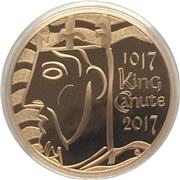 King Cnut the Great, probably better known as King Canute, was King of Denmark, England, and Norway. He was born about 995 and died in 1035. Canute was King of England 1016–1035.
King Cnut the Great, probably better known as King Canute, was King of Denmark, England, and Norway. He was born about 995 and died in 1035. Canute was King of England 1016–1035.Although Canute was an important Anglo-Saxon King (despite being Danish) much of his history is diminished by the Norman invasion in 1066. Canute is often remembered with the story that he sat on the beach and told the sea to 'go back'; he used it to show his flattering courtiers that a King did not possess God-like powers.
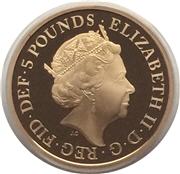 To commemorate the 1000th anniversary of King Canute's ascendence to the English crown, the Royal Mint has struck a new 22 carat gold proof five pounds piece (£5).
To commemorate the 1000th anniversary of King Canute's ascendence to the English crown, the Royal Mint has struck a new 22 carat gold proof five pounds piece (£5). The coin depicts King Canute on the reverse (designed by Lee R Jones), and Queen Elizabeth II's fifth portrait on the obverse (designed by Jody Clark).
Only 150 pieces have been minted to celebrate England's first Viking king. With such a small mintage (One of the smallest mintages for a mainstream British gold coin), the Royal Mint completely sold out within a few days.
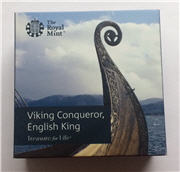 The coin was originally issued in Royal Mint wooden box with an external printed box and a numbered Certificate of Authenticity (COA).
The coin was originally issued in Royal Mint wooden box with an external printed box and a numbered Certificate of Authenticity (COA).For a more extended article see: King Cnut (Canute) and the 2017 Gold 5 Pound Coin
Image credit: M J Hughes Coins.
Mintage: 150 (may include coins in sets)
Minted at The Royal Mint
More information (monarch, year, mint, country, category) can be found below coin listings.
Below are some coins currently being offered on eBay. As an eBay Partner, We may be compensated if you make a purchase.
List items on:
 | 2017 Royal Mint King Canute £5 Five Pound Gold Proof Coin PCGS PR70 DCAM £ 12,999.95 |
 | 2017 £5 British King Canute Coin PCGS PR69DCAM Au.9167 39.94g Coin GC14/700 £ 5,537.51 |
List items on:
Remember 2017 ?
A UK June General Election results in a hung parliament. Prime Minister Theresa May confirms "Brexit means Brexit" as the UK continue negotiations to leave the European Union (EU). Donald Trump is inaugurated as the 45th President of the United States of America and Mike Pence as the 48th Vice President. President Xi Jinping heralds a "new era" for China. New 12-sided pound coin introduced into the UK. BBC announces the first ever female Doctor Who will be played by Jodie Whittaker. Leonardo da Vinci's painting "Salvator Mundi" sells for $450.3 million at auction in New York, a world record price. Prince Harry and Meghan Markle announce their engagement. Australia take an unassailable 3-0 lead against England in the Ashes. Bitcoin makes the headlines as the cryptocurrency rises over 1000% during the year.
Elizabeth II (1952-2022)
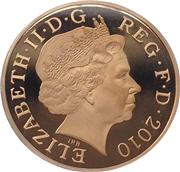 Queen Elizabeth II was the longest reigning British Monarch ever, reigning for over 70 years. Born on 21 April 1926 to King George VI and Elizabeth Bowes-Lyon, she became Queen in 1952 and her Coronation was on 2 June 1953. She died on 8 September 2022. Some coins were released dated 2023.
Queen Elizabeth II was the longest reigning British Monarch ever, reigning for over 70 years. Born on 21 April 1926 to King George VI and Elizabeth Bowes-Lyon, she became Queen in 1952 and her Coronation was on 2 June 1953. She died on 8 September 2022. Some coins were released dated 2023.Queen Elizabeth II issued many coins and was monarch during decimalisation. She married Prince Philip, Duke of Edinburgh in 1947 and had four children. Her eldest son succeeded the throne as King Charles III. House of Windsor.
Category: Gold 5 Pound Coins
Not that many people own Gold Five Pound coins, I suppose mainly because they are an expensive coin even in bullion form. Perhaps even fewer realise there are two basic kinds of gold five pound coin. They are very similar, yet distinct. The Gold £5 Coin
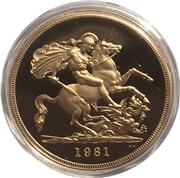
Often referred to as the non commemorative £5 coin or the Quintuple Sovereign as it is exactly five times heaver than a Sovereign (7.9881 x 5 = 39.94g). As one sovereign is nominally one pound then a quintuple sovereign must be five pounds.
The Gold £5 coin has its history deriving from the five guinea coin right back at the start of the 19th Century. In those days a guinea was valued at one pound rather than the one-pound-and-one-shilling it is often remembered as nowadays. George III, George IV and Victoria all issued actual gold £5 coins and others issued a few too, but Elizabeth II began the surge in production, especially from 1980 onwards. From 1990, the £5 coin was minted in Cupro-Nickel too and silver versions were also available.
The Gold Crown
The Crown is another English coin with a long history. You may remember the Half-Crown from pre-decimalisation days, but the Crown has been a commemorative coin for as long as we can remember. The Crown was legal tender at a quarter-pound, which was five shillings (25 pence in decimalised money).
In the Eighties we saw the introduction of the pound coin and the two-pound coin, so the Government decided that the crown needed to be restored to it former glory as biggest denomination coin and the crown was re-denominated to £5 in 1990.
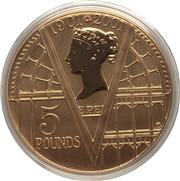
This re-denominated was OK by itself, but as a (still) mainly commemorative coin it was soon available not only as Cupro-Nickel but as silver and ... gold. That meant we had a new, official, gold £5 coin.
It also weighs 39.94g. And to prove its value it has '5 pounds' written on it.
The only difference between the sovereign gold £5 coin and the gold crown is the diameter. The crown maintained its original diameter of 38.61mm compared to the slightly smaller 36.613mm of the sovereign type.
The re-denominated had other effects too. Whether re-denominated is determined as from this point onwards or backward-compatible is unclear to many. The original crown was a gold coin, so does that mean that Henry VIII's gold crowns were the first £5 coins? So the history of coins starts to rewrite itself in some ways, although if this is intended or correct I'm not sure.
The Gold Five-Pound Piece
I've noticed many dealers referring to these coins as '£5 pieces'. Maybe it's a way of avoiding the confusion and grouping the coins into the same category rather than having them as two separate entities. Besides the slight difference in diameter (which is difficult to see as most of these coins are encapsulated in some way) there's little to tell.
If the reverse looks like it commemorated something then it's probably a crown. If the reverse is the same as the reverse of a sovereign of the same year then it could be a five pound coin. Whatever, you have a gold five pounds with almost 40g of gold; it's impressive and they are a great investment.
Five pound coins are often in 4- or 5-coin sets, together with combinations of a sovereign, half-sovereign, double sovereign, quadruple sovereign and maybe some commemorative item or a year-set collectable. They can be bullion, proof or matt-proof.
Despite the high intrinisic value and even higher collector value, five pound pieces are much sought after and are often sold out within days of release causing some of the coins to have a very high price tag.
Which Mint: The Royal Mint
The Royal Mint is the designated place for the UK to mint coins. It dates back well over 1000 years and is a Government-owned company. Formed in the reign of Alfred the Great about the year 886, during the period 1279-1812 it was generally referred to as The Tower Mint as it was housed at the Tower of London. The Master of The Royal Mint has included famous figures such as Sir Isaac Newton.
Since 2010 it has operated as Royal Mint Ltd, a company owned by HM Treasury, under an exclusive contract to supply all coinage for the UK although it also produces medals and coins for other countries. It is currently located at Llantrisant, Wales.
Country of Origin: United Kingdom
The United Kingdom (UK) is the Union of England, Scotland, Wales and Northern Ireland. It is often refered to as Great Britain (GBR). It has a long, rich history. The orignal coinage was Pounds, Shillings and Pence but since decimalisation on 15 February 1971, it is £1 = 100p, that is One Pound = 100 pence. The coinage of the UK is also a long history, the Royal Mint being established as long ago as 886AD when coins were hammered. Today there is perhaps 30 billion coins in circulation, and many (numismatic) collectors coins and sets are issued frequently in gold, silver and other metals.
Try the Gold 5 Pound Coins page on eBay UK
As an eBay Partner, We may be compensated if you make a purchase.
As an eBay Partner, We may be compensated if you make a purchase.
